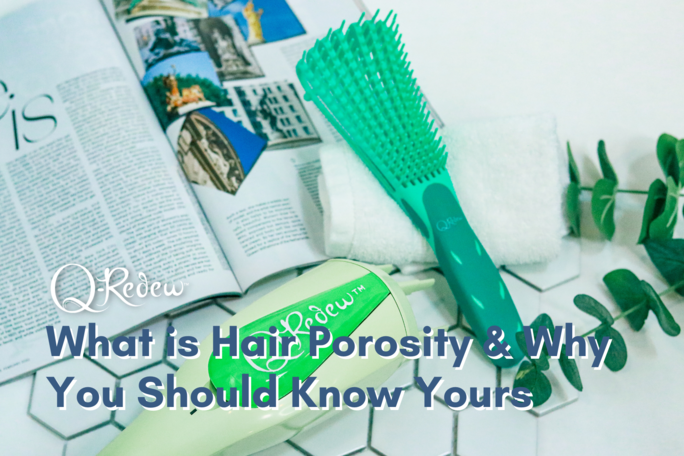You may hear lots of talk of “hair type” in the world of textured hair as many believe that knowing this will help them figure out what products to use. The truth is, this term refers mainly to curl pattern which, on its own, will not help you when it comes to knowing what your hair needs. Your full hair type includes more than just the shape of your curls. One of the most important traits to know is your hair’s porosity level.
Asking someone with hair that looks similar to yours what their hair type is will only get you so far. While their curl pattern may be the same, the porosity, among other things, could be completely different. If you’re not sure what this all means or where you fit in, keep reading!
What Is Hair Porosity?
Hair porosity is your hair’s ability to absorb and retain moisture. This depends on the state of the outer layer of the hair or its cuticle and there are three basic levels of hair porosity: low, normal and high. Your hair will have some characteristics that can give you a clue as to what category your hair fits in on the porosity scale. Let’s discuss each one.
Low Porosity
This type of hair has a tightly closed cuticle layer, making moisture hard to get in. You may have low porosity hair if, when you apply product to your hair, you find that it just sits there without really penetrating. Or, maybe no matter how much your hair appears to be moisturized because it has a sheen to it, it still feels brittle and dry.
High Porosity
High porosity hair has raised cuticles that easily let moisture in but does not retain it. So, if you find that no matter how much you moisturize your hair, it quickly feels dry, as if you never applied anything to it, then it’s possible that you’re on the high porosity end of the spectrum. Because the cuticle layer is always raised or open, moisture is lost just as fast as it is absorbed.
Normal/Medium Porosity
If none of the above sounds like what your hair is going through, awesome! Your hair may very well have a normal porosity level which means the cuticle layer lays flat but isn’t closed so it can easily absorb and retain moisture for a good amount of time.

If you’re still not sure of your porosity based on these descriptions, there are two common tests that can help you determine how porous your hair actually is.
Feel/Slip ‘n’ Slide Test
Take a clean strand of hair and run your index finger and thumb along the strand. If it feels really smooth with no bumps, your hair may have a low porosity level. If it feels rough or bumpy, then your hair is likely highly porous.
The Float Test
Take one or a few strands of clean hair (no product!) and drop them into a glass of water. If the hair immediately sinks to the bottom, it’s quickly absorbing the moisture and is highly porous. If the hair floats, you’ve got low porosity hair. Strands that float somewhere in the middle have a normal or medium porosity.
The Cup Test
One of the easiest methods for determining your hair’s porosity is the cup test. Simply take a shed hair from your comb or brush, and drop it into a cup of water. If the hair sinks right away, it means that it quickly absorbed the water and therefore has high porosity. If the hair remains floating on the top, it is unable to absorb the water, meaning it is low porosity. If the hair gradually sinks to the bottom, it is considered to be normal porosity.
When conducting your test, be sure to use a shed hair instead of broken hair. If the hair is broken, your test will be on a damaged hair so it won’t be accurate. To determine if the hair was broken or shed naturally, see if there is a small whitish tip on one end. That means it was shed directly from the follicle instead of broken.
What Should You Do Once You Know Your Porosity?
The low porosity crew have found the Q-Redew Handheld Hair Steamer to be a lifesaver! Steam helps to open up the cuticle layer of the hair to allow the moisture into the strand. You’ll find that your hair is much softer when using steam in conjunction with your deep conditioners, hot oil treatments, etc.
Lighter products may be best for low porosity hair as well as styling on slightly damp hair. This is another way the Q-Redew comes in handy! Steam adds just enough moisture to the hair where it’s not soaking wet but moist enough for your conditioners and stylers to seep into the cuticle and be more effective.
Melissa aka Meliscurls says, "I have just stepped up my deep conditioning game. Thank you so much Q-Redew now I can steam my low porosity curls so that my hair can fully absorb the benefits of my deep conditioner." Watch for her results!
If your test reveals that you’re on the high-porosity end, Q-Redew steam can still be of use to you when it comes to gentle detangling and stretching the hair without further drying out the hair as a blow dryer would. Your hair may like protein treatments that can help fill in those gaps in the strand. Using leave-in conditioners, heavier products like butters (depending on the thickness of your strands and its density) and oils to seal can help hair that’s highly porous lock in moisture and retain it for a longer period of time while also preventing it from absorbing too much moisture.



